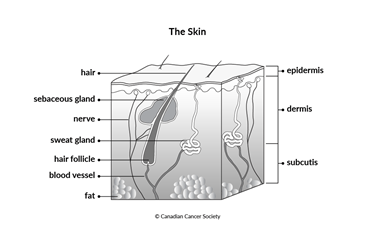The skin
The skin is the body’s largest organ. It covers your entire body and protects you against harmful factors from the environment such as hot temperatures and germs. The skin is important for many body functions.

Functions of the skin
The skin has many functions. It:
- protects the body from heat, cold, sunlight, injury and infection
- controls body temperature
- prevents the loss of fluid and
electrolytes - removes waste products from the body through sweat
- provides the sense of touch, including temperature, pain and pressure
- helps make
vitamin D
Layers of the skin
The epidermis and dermis are the 2 main layers of the skin. They lie on top of a 3rd layer called the subcutis.
Epidermis
The epidermis is the top or outer layer of the skin that you can see. It is a thin, tough layer of skin that protects the body, gives skin its colour and makes new skin. The epidermis is made of several different types of cells.
Squamous cells
Squamous cells are flat cells that make up the outer part of the epidermis (the squamous cell layer). Squamous cells start from keratinocytes, which are cells that contain a tough, protective protein called keratin. As keratinocytes move toward the surface of the skin, they go through changes. The keratinocytes get bigger and flatter and stick together (squamous cells), then eventually die. The dead squamous cells on the surface of the skin are constantly shed from the skin and replaced by new cells.
Basal cells
Basal cells are round cells in the deepest part of the epidermis (the basal cell layer). Basal cells continually divide, make new cells and push the older cells toward the surface of the skin. The older cells eventually become mature keratinocytes and squamous cells.
Melanocytes and other cells
Melanocytes are cells found in the deepest part of the epidermis along with basal cells. They are also found in hair follicles and the retina of the eye. Melanocytes make melanin, which is the substance that gives skin its colour and helps protect the body from some of the harmful effects of the sun. When your skin is exposed to ultraviolet radiation (UVR) from the sun, the melanocytes make more melanin. This causes the skin to darken or become tanned. The extra melanin is transferred to other skin cells (keratinocytes) to protect the skin and the
The amount of melanin made is also affected by a person’s genetic makeup. People with light or fair-coloured skin make less melanin and are at a higher risk of sun damage than people with other skin types. Dark-skinned people have more protection from the sun because their melanocytes are more active and make more melanin.
Other types of specialized cells are found in the epidermis. Langerhans cells help control the immune system by attaching to foreign substances (called antigens) invading the skin. Merkel cells help give the skin its sense of touch.
Dermis
The dermis is the thickest layer of skin under the epidermis. Collagen and elastin are proteins in the dermis that give skin strength, sturdiness, stretch and flexibility.
The dermis contains many structures including:
- blood vessels that carry nutrients and oxygen to the skin
- lymph vessels that help fight infection
- hair follicles, which are small sacs where hair starts growing
- sweat glands that make sweat to control body temperature
- sebaceous glands that make oil to keep the skin and hair smooth
- nerve endings that help provide the sense of touch
Subcutis
The subcutis is the innermost layer of the skin, found under the dermis. It is also called the hypodermis or subcutaneous tissue. It is mainly made up of fat tissue. The subcutis helps keep the body warm and protect the internal organs and delicate tissues from injury.
